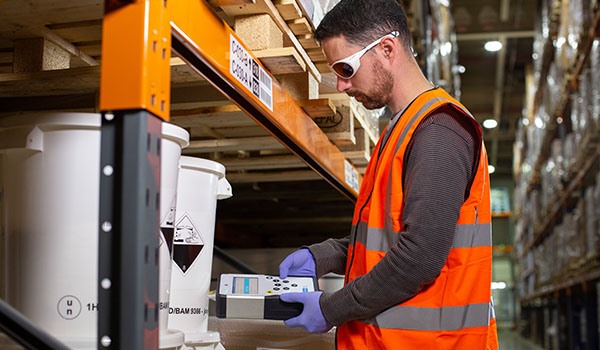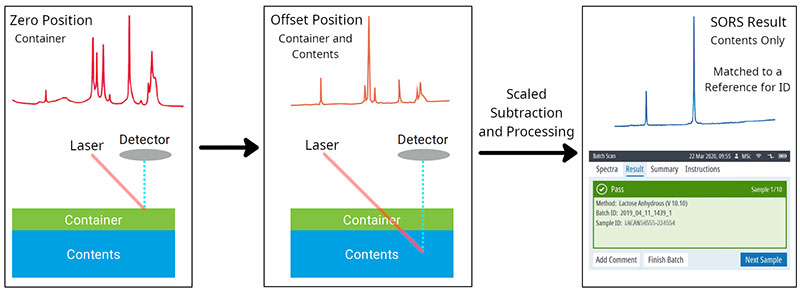
Rapid through-barrier raw material identification
Point. Click. Get a pass or fail result.
It almost seems like magic at first, a workflow so simple it begs the question, why do it any other way? Through-barrier raw material identification is an absolute blessing for anyone receiving a steady influx of bulk raw materials in compliant environments. This is the Vaya’s “raison d’être”: to provide through opaque and transparent container raw material identification, alleviating all the lengthy sampling and analysis steps typically associated with bulk material verification processes. The end result provides users with a simple “yes” or “no” answer without needing to cut, tear or otherwise open containers in any way. The fact this is all done using nothing more than monochromatic light from a laser makes it even more impressive.
Vaya is capable of identifying raw materials through common containers, from thin plastic and glass to thick plastic and paper sacks. Like any novel scientific approach, there are of course limitations to this technology; some containers (such as metal drums and fiberboard) block all light from reaching the sample inside, and thus require manual opening. However, usually these containers have a liner housed inside that does not need to be opened, keeping the Vaya workflow essentially the same even in these cases. In most instances the Vaya can even provide accurate results through notoriously difficult blue plastic barrels, as well as with two different layers of containers between it and the sample!
Trusted answers from SORS: spatially offset Raman spectroscopy

The scientific foundation of how the Vaya can peer through containers and identify the contents inside is as straight-forward as it sounds. Relying on the fact that everything around us interacts with light in a unique fashion, including a container and its contents, the Vaya starts its process by emitting two pulses of laser light, spatially offset using two different positions. The positions chosen depend on the type of container, and will give us two necessary pieces of information: the spectrum of container and contents, and the spectrum of just the container, all of which takes about a minute or so. Using some clever mathematics, the Vaya can then isolate the spectrum of the contents alone, and compare this with a previously developed model to determine degree of correlation. If the contents’ spectrum agrees with the model, a PASS result is given, indicating the contents inside the container are indeed what we expect. It’s really that simple.
Monumental time savings (and cost savings too!)

By far the biggest benefit provided by the Vaya is the immense amount of time saved confirming the identity of incoming bulk raw materials. Current methods of doing so involve a complex, multi-stage process of opening containers, sampling some material, confirming identity by analyzing said material in dedicated analysis rooms using conventional technologies (FTIR, conventional handheld Raman systems, etc.), and then cleaning the room to avoid contamination between batches. Overall, this process can take several hours per material, with backlogs getting well into days or even weeks under most circumstances. Reducing each instance of raw material identification down to mere minutes in the warehouse not only saves significant time. It also saves the cost of cleaning and maintaining the separate sample analysis area and equipment necessary for this type of routine identification. It’s no wonder why the Vaya handheld Raman spectrometer has quickly become a staple in many bulk material receiving departments.
Further reading
- Application Note: Rapid Testing of Solvents Through Amber Bottles using an Agilent Vaya Handheld Raman Spectrometer
- Application Note: Verification of Nutraceutical Raw Ingredients Directly Through Packaging
- Application Note: Identification of Commercially Available Oligonucleotide Starting Materials Directly Through Containers
- Application Note: Differentiating Biopharmaceutical Raw Materials Using Spatially Offset Raman Spectroscopy
- Application Note: Rapid Identification of Polysorbates 20 and 80 Directly Through Amber Bottles
- Application Note: Identifying Raw Materials Directly Through Paper Sacks
- Application Note: Rapid Identification of Raw Materials Inside Packaging
- Spatially Offset Raman Spectroscopy Overview
Molecular spectroscopy webinar series
Check out our latest Vaya webinar to learn about through-barrier raw material ID, sustainability, and much more:
